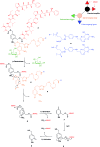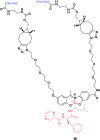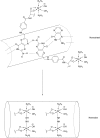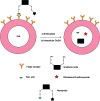Advances in targeting the folate receptor in the treatment/imaging of cancers
- PMID: 29675145
- PMCID: PMC5890329
- DOI: 10.1039/c7sc04004k
Advances in targeting the folate receptor in the treatment/imaging of cancers
Abstract
The folate receptor (FR) is a recognised biomarker for tumour cells due to its overexpression on a large number of tumours. Consequently, the FR has been exploited by many diagnostic and therapeutic tools to allow targeted delivery to, and imaging of, cancer cells. Herein, we describe the many different approaches by which this has been achieved, including the attachment of folate to potent chemotherapeutic drugs to form FR-targeting small molecule-drug conjugates (SMDCs), FR-targeting antibodies (as antibody alone and as an antibody-drug conjugate), and in the form of complementary nanotechnology-folate platforms; as well as imaging variants thereof. The potential of exploiting the FR for targeted therapy/imaging has the potential to revolutionise the way several cancers are treated. These FR-targeted technologies can also pave the way for inspiring further sophisticated drug conjugates, especially as this receptor is being targeted by use of several complementary technologies: small molecule, nanoparticle and protein-based - thus providing broad and distinct knowledge in the area.
Figures




















Similar articles
-
Targeted drug delivery via folate receptors.Expert Opin Drug Deliv. 2008 Mar;5(3):309-19. doi: 10.1517/17425247.5.3.309. Expert Opin Drug Deliv. 2008. PMID: 18318652 Review.
-
Targeting the folate receptor: diagnostic and therapeutic approaches to personalize cancer treatments.Ann Oncol. 2015 Oct;26(10):2034-43. doi: 10.1093/annonc/mdv250. Epub 2015 Jun 10. Ann Oncol. 2015. PMID: 26063635 Review.
-
The folate receptor as a rational therapeutic target for personalized cancer treatment.Drug Resist Updat. 2014 Oct-Dec;17(4-6):89-95. doi: 10.1016/j.drup.2014.10.002. Epub 2014 Oct 8. Drug Resist Updat. 2014. PMID: 25457975 Review.
-
Tumor detection using folate receptor-targeted imaging agents.Cancer Metastasis Rev. 2008 Dec;27(4):655-64. doi: 10.1007/s10555-008-9155-6. Cancer Metastasis Rev. 2008. PMID: 18523731 Review.
-
Delivery of chemotherapeutic drug targeting folate receptor to oral cancer cells using functionalized carbon nanospheres.Biomed Mater. 2023 Aug 2;18(5). doi: 10.1088/1748-605X/ace8de. Biomed Mater. 2023. PMID: 37467764
Cited by
-
Heterocyclic Substitutions Greatly Improve Affinity and Stability of Folic Acid towards FRα. an In Silico Insight.Molecules. 2021 Feb 18;26(4):1079. doi: 10.3390/molecules26041079. Molecules. 2021. PMID: 33670773 Free PMC article.
-
The Evolution of Molecular Recognition: From Antibodies to Molecularly Imprinted Polymers (MIPs) as Artificial Counterpart.J Funct Biomater. 2022 Jan 28;13(1):12. doi: 10.3390/jfb13010012. J Funct Biomater. 2022. PMID: 35225975 Free PMC article. Review.
-
Conventional and Chemically Programmed Asymmetric Bispecific Antibodies Targeting Folate Receptor 1.Front Immunol. 2019 Aug 21;10:1994. doi: 10.3389/fimmu.2019.01994. eCollection 2019. Front Immunol. 2019. PMID: 31497024 Free PMC article.
-
Plasma Surface Polymerized and Biomarker Conjugated Boron Nitride Nanoparticles for Cancer-Specific Therapy: Experimental and Theoretical Study.Nanomaterials (Basel). 2019 Nov 21;9(12):1658. doi: 10.3390/nano9121658. Nanomaterials (Basel). 2019. PMID: 31766559 Free PMC article.
-
Imaging of Oligometastatic Disease.Cancers (Basel). 2022 Mar 10;14(6):1427. doi: 10.3390/cancers14061427. Cancers (Basel). 2022. PMID: 35326586 Free PMC article. Review.
References
-
- Krall N., Pretto F., Decurtins W., Bernardes G. J. L., Supuran C. T., Neri D. Angew. Chem., Int. Ed. 2014;53:4231–4235. - PubMed
-
- Valeur E., Knerr L., Ölwegård-Halvarsson M., Lemurell M. Drug Discovery Today. 2017;22:841–847. - PubMed
-
- Kularatne S. A., Wang K., Santhapuram H. K., Low P. S. Mol. Pharm. 2009;6:780–789. - PubMed
-
- Bhuniya S., Maiti S., Kim E. J., Lee H., Sessler J. L., Hong K. S., Kim J. S. Angew. Chem., Int. Ed. 2014;53:4469–4474. - PubMed
Publication types
LinkOut - more resources
Full Text Sources
Other Literature Sources

